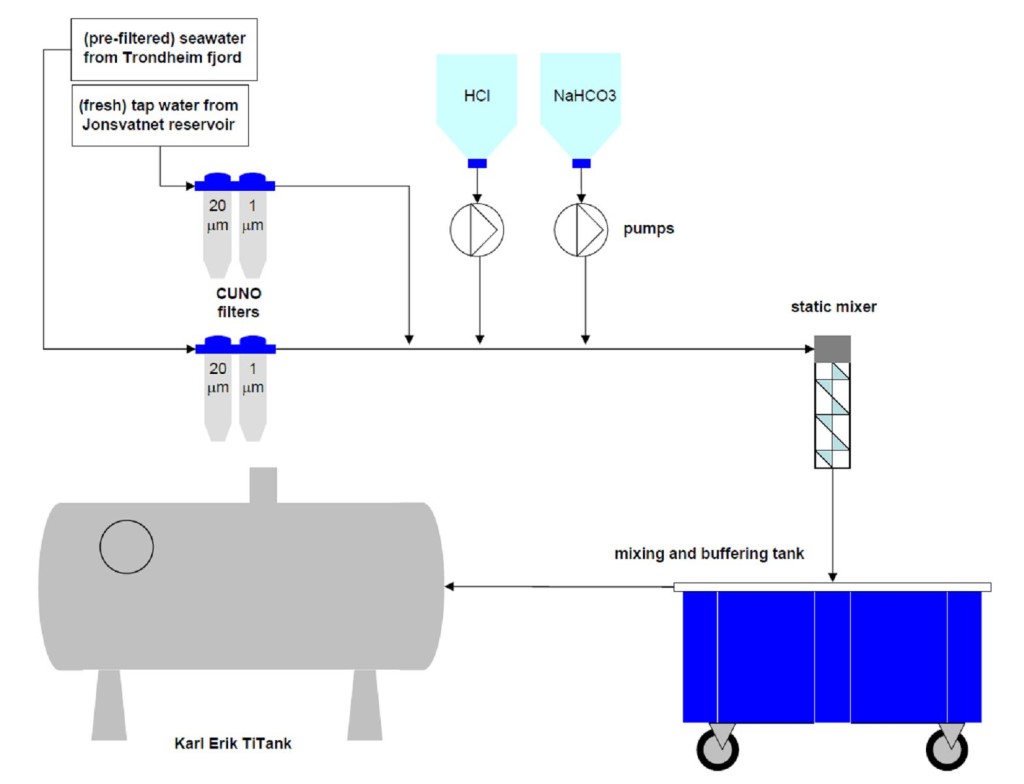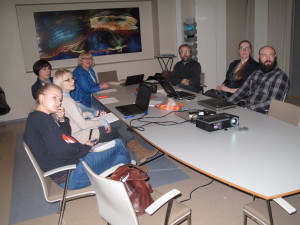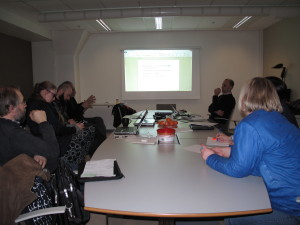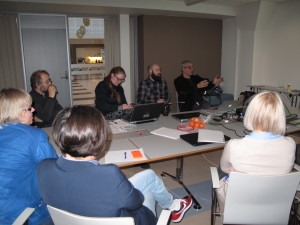| DATE |
Event |
Description / Photo |
| 23 April 2014 |
PROJECT KICK-OFF CONFERENCE Polish-Norwegian Research ProgrammeWarsaw Hotel Marriott,Warsaw, Poland CO2MARINE presentation
|
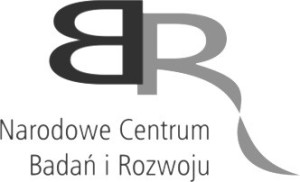 |
| September 24-26, 2014 |
CO2MARINE kick-off meeting and Steering Committee meeting Sealab NTNU/SINTEF,Trondheim, Norway |
 |
| October 2014– June 2015 |
Design and construction of sample-holder in the TiTank (WP1-3) SINTEF/NTNU Trondheim, Norway |
Unique sample-holder (so called carousel) was designed and constructed to fit the TiTank and carry 51 tube-shape containers, each representing one analytical replicate. The carousel can rotate inside the TiTank and allows sampling containers through access port and a decompression chamber during high pressure CO2-experiments without decompression the tank. The carousel is entirely made of titanium and plastic of high chemical resistance which are not affected by the corrosive properties of seawater at the relevant physical conditions, ensuring no contamination from the carousel during the experiments. |
| January 2015 |
Laboratory test experiments on sediment stabilization dynamics (WP1) University of Gdansk, Poland |
Laboratory experiments on surface sediments from the Gulf of Gdańsk (southern Baltic Sea) were performed in carbon-fibre tube-like containers of shape and size similar to those which will be used in the TiTank to determine stabilization period of sediments. Since sediment properties change due to sampling and handling stabilization period is needed prior to the start of laboratory experiments. Sediments were incubated at 7⁰C over seven days and the following variables were measured in overlying-bottom water (1.5 cm above the sediment surface) 3, 5, 6, 7 days after incubation started: DSi, PO43-, NO2-, O2. Duration of the stabilization period was estimated 6-7 days which agrees well with previous similar incubation experiments (e.g. within COST-IMPACT project).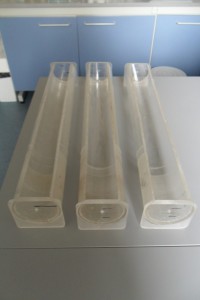 |
| January 2015 |
Publication by Yakushev et al. (2014) on modelling sediment-water interface chemistry (WP2) NIVA, Oslo, Norway |
Yakushev E.V., Protsenko E.A., Bruggeman J. 2014. Bottom RedOx Model (BROM) general description and application for seasonal anoxia simulations. NIVA Rapport 6758-2014, ISBN 978-82-577-6493-7A preliminary model setup for the B3 region in the southern Baltic Sea was tested and physical, chemical and biological data which are required as input data were defined including T, S, Kz (coefficient of turbulent exchange), current velocity, O2, NO3-, NO2-, NH4+, PO4-3, Si, TA, TOC, DOC, DON, DOP, POC, PON, POP, H2S, SO4-2, trace metals, phytoplanktonic productivity and biomass, zooplanktonic and benthic productivity and biomass, bacterial productivity, rate of dark carbon fixation. |
| February 2015 |
Construction of system for water dilution (WP1-3) SINTEF/NTNU, Trondheim, Norway |
Automatic system for dilution of sea water that is supplied to the Titank from the Trondheimsfjorden was designed and constructed at SINTEF/NTNU in order to make basic water variables (i.e. salinity , pH and total alkalinity) similar to the Baltic conditions. The use of sea water of similar characteristics to that from the Gulf of Gdańsk will reduce stress of tested animals related to laboratory conditions. Comparison of chemical variables between water mixed in the dilution system and overlying-bottom water in the Gulf of Gdańsk showed fairly similar characteristics except concentration of Mg and total alkalinity. Differences in concentration of other elements such as K, Ca, Fe and of humic substances are considered negligible. |
| February 26, 2015 |
Workshop Polish-Norwegian and Czech-Norwegian CCS projects supported by EEA and Norway Grants Research Council of Norway Oslo, Norway |
Oral presentation of the CO2MARINE project. |
| January-March 2015 |
Sampling campaigns in the Gulf of Gdańsk, southern Baltic Sea (WP3) University of Gdansk, Poland |
Three sampling cruises were made in January-March , 2015 onboard research vessels „Oceanograf II” and „HESTIA” to define areas of high natural density of the telinid bivalve, Baltic clam Macoma balthica and ragworm Hediste diversicolor in the Gulf of Gdańsk, southern Baltic Sea. Quantitative samples were taken in triplicate with a Van Veen grab (0.1 m2 catch surface area) and by dredging with a rectangular bottom dredge (30 x 139 50 cm and 1 mm internal mesh size). Based on the data collected, two different sampling sites were identified for winter sampling of bivalves – MW (water depth 30 m) and polychaetes – the Brave Vistula (BV, water depth 5 m), respectively. 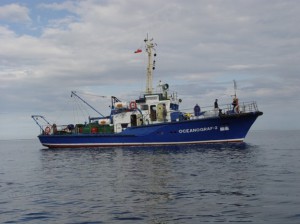 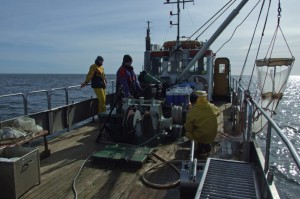 |
| February-April 2015 |
Test experiments on assimilation of phytoplanktonic food by benthic species (WP3) University of Gdansk, Poland |
Test experiments on assimilation of phytoplanktonic food (BioTrix, Dag Altin, Trondheim, Norway) by two model macrobenthic species Macoma balthica and Hediste diversicolor were performed in order to verify the applicability of the reared food for feeding animals during CO2-exposure experiments in the TiTank. The food was a mixture of three live phytoplanktonic species (1/1/1 v/v/v): Dunaliella tertiolecta ( mean cell size 9.6 µm), Rhodomonas balthica (7.6 µm) and Isochrysis galbana (4.6 µm). Animals were fed with microalgae at a concentration of 30 106 cell/l at stable temperature 10⁰C under laboratory conditions over two weeks. All individuals of both test species showed 100% survival rate and good locomotory activity confirming sufficient nutritive value and good assimilability of the phytoplanktonic food. |
| January -June 2015 |
Development of analytical methods for enzyme activity determination (WP3) GUMED/University of Gdansk, Poland |
Analytical methods for determination of enzyme activity in the Baltic clam Macoma balthica and ragworm Hedsite diversicolor were developed and validated using protocols which are routinely used in vertebrates. The following enzymes were tested: Carbonic Anhydrase (CA), Carbonic esterase, Catalase (CAT), Glutathione S-transferase (GST), Glucose-6-phosphate dehydrogenase (G6PDH), Lactate dehydrogenase (LDH), Isocitrate dehydrogenase (IDH), Malic enzyme (ME). In addition, other enzymes are also planned to be tested: Superoxide dismutases: Cu-Zn-SOD, Mn-SOD, Glutathione peroxidase, Glutathione reductase, GSH level, Octopine dehydrogenase. |
| April 17, 2015 |
CO2MARINE working meeting SealabNTNU/SINTEF,Trondheim, Norway |
Discussion of so far activities and progress of the project.  |
| May 24-27, 2015 |
18th Pollutant Responses in Marine Organisms (PRIMO) Symposium Carion Hotel,Trondheim, Norway |
Poster presentation of the CO2MARINE project. |
| July- August, 2015 |
Feeding experiment on the ragworm Hediste diversicolor GUMED/University of Gdansk, Poland |
The developed and validated methods for enzymatic activity determination were applied to a feeding experiment on the ragworm Hediste diversicolor which were collected in the Gulf of Gdańsk (southern Baltic Sea). The organisms were exposed to a short-term starvation (48 h) and post-starvation 12h feeding to track changes in enzyme activities due to potential variations in food availability. No differences in the concentration of the main metabolic enzymes such as Lactate (LDH), Isocitrate dehydrogenase (IDH), Malic enzyme (ME), Glucose-6-phosphate dehydrogenase (G6PDH) were found, neither were there any significant differences in antioxidant enzymes’ activities (catalase ‘CAT’, superoxide dismutase ‘SOD’, glutathione peroxidase ‘GPx’). It is therefore hypothesized that Hediste diversicolor is not sensitive to starvation and a short-term food shortage does not affect metabolic status of the polychaete |
 Polski
Polski








